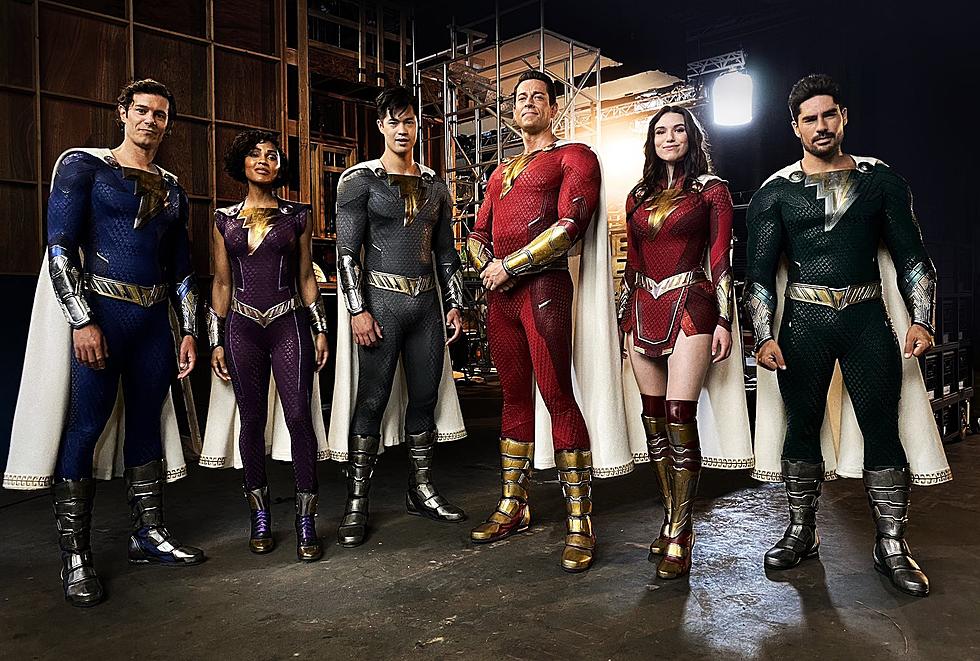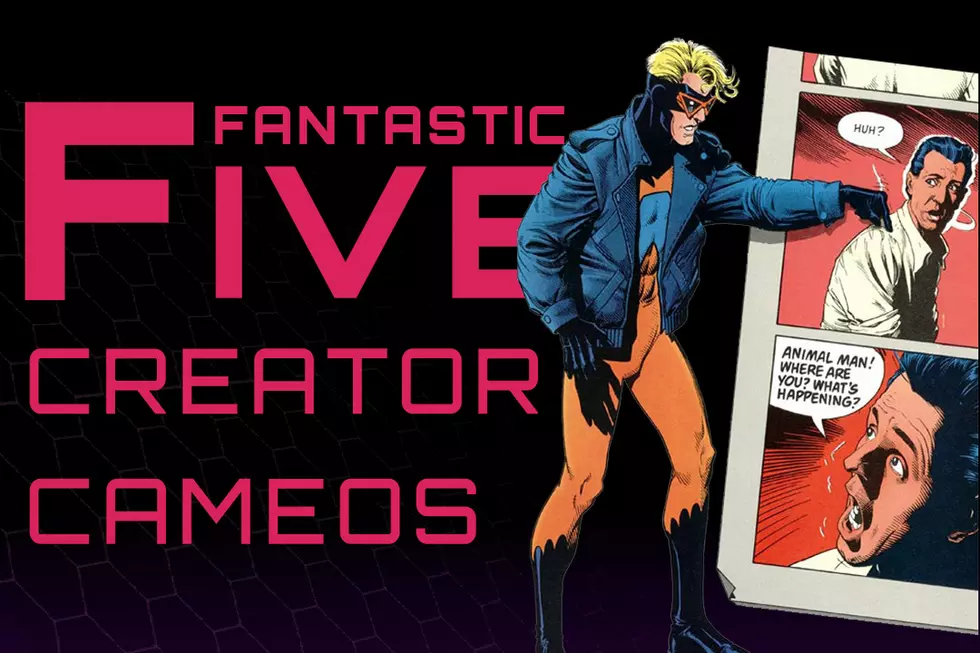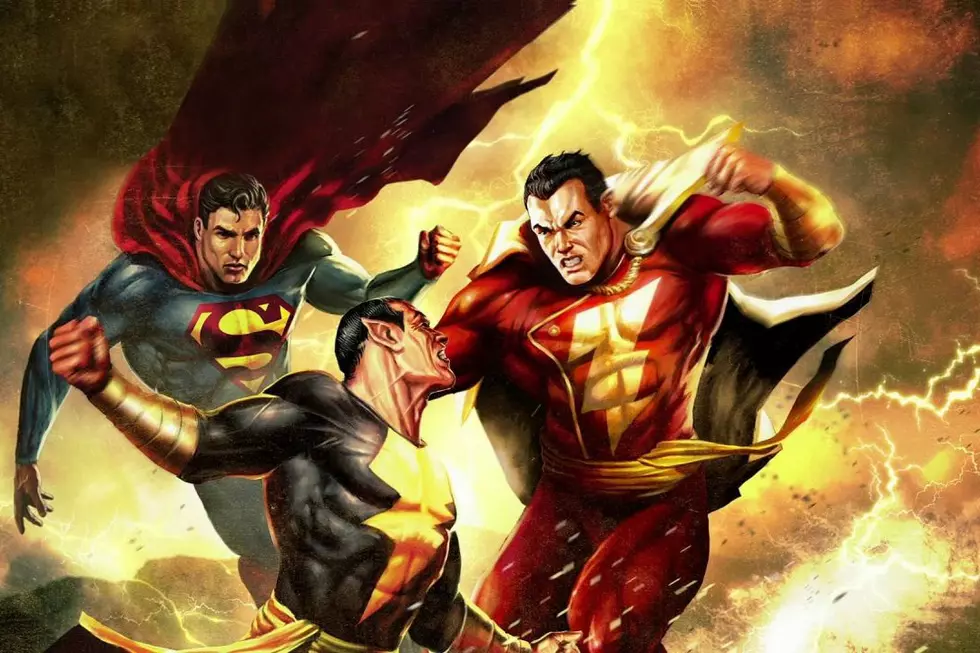
The Multiversity Annotations, Part 5: Thunderworld Adventures – “Just Clever Enough.”
Teased for years and finally launched in 2014, The Multiversity is a universe-jumping series of DC Comics one-shots tracking the cosmic monitor Nix Uotan and an assemblage of star-crossed heroes as they attempt to save 52 universes and beyond from a trippy cosmic existential threat that, like much of Morrison’s best work, represents something far more mundane and relatable. Tying back into the very first Multiverse story in DC’s history, the heroes of these universes become aware of this threat by reading about it in comic books… comic books that, it turns out, take place in neighboring universes. Indeed, writer Grant Morrison continues his streak of highly metatextual DC cosmic epics with this eight-issue mega-series (plus one Tolkienesque guidebook).
Described by Morrison as “the ultimate statement of what DC is”, The Multiversity naturally offers the reader much beyond the surface level adventure, and that means annotations. Rather than merely filling out checklists of references, my hope with this feature is to slowly unearth and extrapolate a narrative model for Morrison and his collaborators’ work on The Multiversity; an interconnecting web of themes and cause and effect that works both on literal and symbolic levels.
The fourth issue of the series, Thunderworld Adventures, with art by Cameron Stewart, colors by Nathan Fairbairn and letters by Steve Wands, was initially described by Morrison as taking the All Star Superman approach to Captain Marvel. Set on Earth-5 — previously Earth-S in the pre-Crisis on Infinite Earths DC Multiverse — it's far more evocative of the original Fawcett Comics incarnations of these characters than any versions that have been in the DC Universe since. Lighthearted and fun, with gorgeous art by Stewart and Fairbairn and a lettering style from Wands evocative of the neo-C.C. Beck take Jeff Smith took in his recent Monster Society of Evil prestige miniseries, it's the anti-Pax Americana in tone, subject matter and symbolism, while maintaining a consistency of message and intent.
Page 1
The Rock of Eternity — where the wizard Shazam lives — has been mentioned in Morrison’s work before, but I believe it’s only appeared for a short cameo in the “Crisis Times Five” arc of Morrison’s JLA run, in issue #28. Notably, however, the Map of the Multiverse places it at the very center of the multiverse with the House of Heroes superimposed over it — so, presumably, there’s one Rock of Eternity in the entire multiverse. I’m not ruling out the possibility of an explanation for this in next month’s Guidebook, but this Rock of Eternity seems to be a separate place than the one in the mainline New 52 DC Universe as seen in Geoff Johns and Gary Frank’s “Curse of Shazam!” backups in Johns’s Justice League run, namely because A) it’s intact and B) Shazam is a white dude here.
Of course, Shazam is the kind of concept that could just look different from different perspectives.
Pages 2-3
Not to read too much into it, but it does seem somewhat significant that Shazam is directly addressing us, the reader — or, at the very least, the storytellers, instructing them to move the “camera” (as it were) closer to him. On the top half of the page we see the Seven Sins of Man, the antitheses of the seven gods that give Captain Marvel his strength. Seven sins, seven gods, seven virtues, seven days of the week — the number seven comes up a lot in Captain Marvel’s mythology, so of course Morrison has to manipulate it by adding an eighth day of the week to fit into Multiversity’s octal motif.
It’s worth noting that, in many ways, Thunderworld is a funhouse mirror version of Pax Americana — it makes a number of the same points, but in far more direct, streamlined forms, opting for childlike wonder over cynical precision. Certainly a major difference is the way the two books treat time — in Pax it’s as exact as possible, set on a strict timeline with varying layers of mappable cause and effect. Here it’s just a quantifiable mass you can mine and manipulate, as far removed from quantum physics and Morrisonian multi-dimensional perspective as you can get.
Page 4
Judging by the size of his mechanical Rock of Eternity, I think Thaddeus Bodog Sivana might have some compensation issues.
Morrison lays the main theme pretty thick in this issue, starting with this page, with Sivana bragging about having found an “alternative, scientific explanation” of Captain Marvel’s panels. In yet another emotional barrage against my academic self-esteem, Morrison has again written a whole comic about how people who try to overanalyze and “explain” the wonder of superhero comics are megalomaniacal, selfish and sapping the magic out of the world for children.
Sigh.
Page 5
Originally, Sivana had four children; his daughter, Beautia, the Empress of Venus (no, really), seems to be absent here. As you can probably guess, Magnificus (I will never get tired of typing that) has a different mother than Thaddeus Sivana Jr. and Georgia, although here Sivana refers to “your mother” to all three, so that might not apply to the new Earth-5.
Page 6
Billy Batson is Captain Marvel’s alter ego, a kid reporter for Whiz Media (previously Whiz Radio, obviously). There’s nothing particularly specific about the historical references in the first panel, other than the fact that the future soldier is pretty clearly Master Chief from the Halo series (willing to bet that’s Stewart’s affectation). Billy Batson from later in the book loops back to this page, informing “young” Billy that he should watch the sun and the clock to take note of the quick passage of time on the eight-hour Sivanaday. I’ll bring it up as we go on, but you’ll note that as the ensuing battle goes on, the sky quickly goes from blue to yellow to twilight, and nothing about this scene makes it look like a twelve-hour battle.
Page 7
I can’t think of anything the car’s license plate (CT-8450) could be referring to, although I’m open to correction. This exchange — “You think you’re so clever, don’t you?” / “Just clever enough.” — is a direct mirror of Billy’s exchange with Black Sivana later in the book, when he’s sending Billy the message we just saw on the previous page.
Page 8
Captain Marvel, everybody!
Page 9
Marvel whistles, simultaneously blowing out Junior and Georgia’s eardrums and summoning both Mary Batson and Freddie Freeman, a.k.a. Mary Marvel and Captain Marvel, Jr. (obvious counterparts to Georgia and Sivana Jr.). Mary’s writing her good deeds in her good deeds ledger, a real thing she did in the Silver Age (discovering it is how Uncle Marvel, who we’ll see later, discovered her secret) because… she’s an altruist with an ego, apparently. Freddie’s working at a newsstand that sells comics, which is how you know this must be an alternate Earth — we see Society of Super-Heroes, the second issue, and a random Batman issue to once again illustrate that the mainline DC Universe is fiction in the other worlds of the Multiverse.
Magnificus takes on Captain Marvel himself, illustrating the isomorphic mapping of Sivanas to Marvels going on in this book.
Page 10
We see that Sivana also has a copy of Society of Super-Heroes, and it’s what gave him the idea to communicate with the Sivanas of the multiverse. This page also has the only mention/showing of Ultra Comics in the issue, in the form of the close-up on the page from Society of Super-Heroes where the Atom is reading it in Doc Fate’s tower. I suspect it’s no coincidence, as a result, that this world where nobody reads Ultra Comics is also the only issue so far that doesn’t end on a cliffhanger (or, in the case of Pax, begin on one). Sivana’s comment about the Earth never being enough for him is a reference to his time spent raising his children on Venus prior to meeting Captain Marvel, where he also met the mind-controlling caterpillar Mister Mind, who actually formed this current multiverse way way back in 2007 at the end of 52.
As for the Sivanas of the Multiverse on the bottom half, some of the Earths are pretty easily recognizable — the black Sivana is probably from Earth-23 (where Calvin Ellis is from), the lady Sivana from gender-swapped Earth-11, the vampire Sivana from the vampire Earth-43, the snake Sivana from Captain Carrot’s Earth-26.
I’m really looking forward to finding out more about Earth-Luchador, although probably not as much as Chris Sims is.
In any case, the mechanical Rock of Eternity Sivana used to contact the alternate Sivanas is the closest this book comes to having a Transmatter Symphonic Array like the ones built by Lex Luthor, Doc Fate, Alexis Luthor, etc.
Page 11
The first row here simply recapitulates and confirms that Sivana got the idea from Society of Super-Heroes, but the second half is interesting in the way Sivana’s speech balloons are behind Shazam’s cage bars. Much like the dove cage in Pax represented the restriction of the eight-panel grid, so here does the view from Shazam’s cage, forcing a flow of time onto a wide-open view. Notice how Fairbairn dulls the colors from the rich palette of the Rock of Eternity to a dull fluorescent nine-to-five office hellscape, with Shazam himself diminished by the blandness of Sivana’s intellectual approach to magic.
Page 12
I love the detail of the robot bringing in the office cactus.
Shazam restates the basic theme of the issue (and of Pax); the fact that picking this stuff apart and attempting to reduce it to “cogs and wheels” reduces the magic — the book’s “secret heart” — to something that isn’t “worth anything.”
Page 13
I refuse to believe Sivana proudly yelling “THE FOUNTAINHEAD!” in a dull office built in the Rock of Eternity isn’t an Ayn Rand dig, and nothing you say will convince me otherwise.
Shazam, in his forgetfulness, gives away the fact that his lightning staff is the actual source of Captain Marvel’s powers.
Pages 14-18
Not much to say here other than that this is a really beautiful and joyful fight scene. Notice how, due to the accelerated passage of time on Sivanaday, it goes from daylight to sunset in a single panel, just as Captain Marvel, Jr. bats Captain Sivana to the moon with construction equipment.
Page 19
Here we’ve got a pretty weird inversion of the Mary Marvel subplot from Final Crisis, where she gets possessed by Desaad and turned into what I can only describe as a homicidal punk dominatrix, like a fascist-chic Burning Angel star, where leering old man Desaad corrupted the image of the most wholesome girl in all of superhero comics.
It wasn’t subtle, but not much in Final Crisis was — it was dense, but certainly not subtle.
In any case, here Georgia’s revelling in her newly-minted femme-fatale status, while Mary Marvel counters with the importance of integrity and inner beauty.
Page 20
Georgia then gets played like a fiddle by a faux-fawning Freddie Freeman, and while this at least somewhat justifies the aesthetics of Georgia’s… titillating… transformation, I’m a little uncomfortable with some of the beauty politics here, since this is basically two naturally good-looking kids making fun of the less traditionally attractive nerdy girl, which is… kinda shitty, to be honest, and at odds with the legitimately wholesome vibe of the rest of this issue. I get that this is supposed to be the vain, selfish Georgia getting her comeuppance, but it just comes off as cruel.
Page 21
The Monster Society! Here we’ve got one of Mr. Mind’s Crocodile Men mixed with the murderous Sobek from 52 they inspired and the final, evolved butterfly form of Mr. Mind himself, also from 52, on the left. On the right, the dude who looks like Blockbuster from the Society of Super-Villains is Oom the Mighty, while the big robot is, I think, a reimagination of atomic robot Mister Atom. The black cloud behind them is likely Hoppy the Marvel Bunny villain the Storm King.
Page 22
The rest of the Marvel Family — the three Lieutenant Marvels (named, seriously, Fat Marvel, Tall Marvel and Hill Marvel), the powerless Uncle Marvel, and the super-badass talking tiger with a jetpack, Tawky Tawny. Uncle Marvel keeps pretending to have powers, and that farce is indulged by the rest of the family, hence his reluctant admission of needing to direct the action with a megaphone from the back.
Pages 24-25
Note that the clock is showing the same hand configuration (9:00) as the one over the train station back on page 6; that entire fight took place over twelve Sivanaday “hours.” Captain Marvel barrels through the train tunnel that Billy Batson went through to gain the wizard’s power, but…
Pages 26-27
Here we get an illustration of the Rock of Eternity as multiversal singularity: these are presumably the (I’m guessing) 52 trains going from each Earth to the Rock. These are all versions of the original train that took Billy to the Rock in the very first Captain Marvel story; presumably they’re all in action due to the Transmatter Symphonic Array. (Additionally, the last time Billy took this trip, he was in the train car).
Page 28
Here we’re introduced to the issue’s big dangling plot point — the Hannibal Lecter Sivana, covered in blood and glimpsed through a dark, static-laden screen. I’m hoping we’ll get to find out what Earth this dude is from next month in the Guidebook.
Page 30
We also meet what I can only presume is that guy’s counterpart, the completely normal-looking Sivana of, I can only guess, our world (Earth-33). I’d suspect that he was from the morality-reversed Earth-3, but that’s been completely destroyed according to recent events in Justice League. He also looks a lot like the Dr. Sivana of the New 52 before the events of the Johns/Frank series, where he was a normally-proportioned, well-built scientist guy instead of the cartoonishly diminutive traditional Sivana.
Page 31
Again, Sivana lays out the general gist of the issue’s conflict — magic vs. science, or, interpreted through the narrative lens of Multiversity, wonder vs. analysis. Sivana’s attempting to dissect the nature of magic and destroying and devaluing it in the process, much like Captain Atom tried to dissect his dog to investigate the nature of the bond of love between them.
Page 32
That places Captain Marvel’s statement here about what the Wisdom of Solomon says in a different context, though — that wonder and analysis can coexist and support each other, and that pitting the two against each other simply props up an unnecessary false dichotomy.
Black Sivana here is the closest we get to an appearance of Captain Marvel’s other arch-nemesis, Black Adam, in this issue, with a highly evocative costume.
Page 34
Harkening back to Billy Batson’s origins in radio rather than the Internet, much like quartz crystal resonance can be used to transmit radio waves, Billy uses the crystallized Suspendium to transmit the message about Sivanaday’s short span from here to page 6 (which is exactly as far from the beginning of the issue as this page is from the end).
Page 35
Again, a mirroring of the events after Billy received the timecast — saying, “Shazam!” after the, “You think you’re so clever?” / “Just clever enough.” interaction.
Page 36
We get the explanation of Billy’s message here, too — Sivanas, all being selfish, megalomaniacal types, all screwed each other on the Suspendium, betting they’d each be the only one to have that idea.
Page 37
Torture Porn Sivana’s threat about wanting Mary Marvel is presumably what leads to Mary Marvel’s eventual presence in the House of Heroes, judging by her appearance with Earth-20 Abin Sur, Captain Carrot, Earth-23 Superman and company on the cover of #1. The idea of good always winning unless there are cosmic shenanigans echoes the conceit of JLA: Earth-2, where, just as good always triumphed in the regular DC Universe, evil always triumphed on the antimatter Earth in the end, no matter what short-term gains good could make. Indeed, the tagline for Final Crisis was “the day evil won,” and even then Darkseid was eventually defeated.
Pages 38-39
And, of course, good has triumphed — the sun’s rising on a new day, it’s again 9 AM, the Marvel Family’s defeated the Monster Society. We return to Society of Super-Heroes, again opened to the page where the Atom is reading Ultra Comics, as Captain Marvel laments the open-ended, threatening conclusions of the other issues of Multiversity.
Mary Marvel’s comment about wanting to meet another version of herself not only mirrors Sister Miracle’s similar comment at the end of The Just, but is presumably a dark joke about the pretty crappy fate of her Earth-0 counterpart back in Final Crisis.
Page 40
Parallax’s, “I’ll get out and destroy everything!”, it’s worth mentioning, wasn’t in the actual copy of Society of Super-Heroes that came out here, even though the exact art it’s placed over is directly from that book. Does that mean that our Earth-33 versions are somehow sanitized? He crumples up the book and throws it in a wire mesh trash can — again, a cage, like the panel borders of Pax Americana and Shazam’s prison — before a big open flight into the sky, unbounded by the panel borders, flanked by doves flying free. The anti-Pax Americana, indeed.
A Note About the Gentry:
One theory I’ve seen going around since S.O.S. is the idea that each of the universe-specific issues so far has been infected by a specific member of the Gentry. Parallels were drawn between Faust’s zombie army in S.O.S. and the Gentry monster Demogorgunn; the Grey Lady from The Just is clearly Dame Merciless. Lord Broken is portrayed as a haunted house with eyeballs staring through windows, trapped within their grids, much like the characters in Pax were trapped within the eight-panel grid of their world, staring out at us.
Similarly, this issue features the conflict between analysis and wonder, science and magic, with the over-analysis of magic and the attempt to quantify it leading to the devaluation of said magic. As a result, it would appear that — if this theory is accurate — the Gentry member who’s infected Earth-5, through the guise of Sivana, is in fact the aptly-named Intellectron.
This leaves Hellmachine for Earth-10 and Mastermen, while presumably the threat in the final Earth-specific issue — Ultra Comics, on Earth-33, our Earth — will be more existential. I’m still not 100% sold, but after the last two issues, I’m far more receptive to it being a possibility.
More From ComicsAlliance

![Five Stars: Starting At The End With Jeff Smith [Interview]](http://townsquare.media/site/622/files/2017/03/FiveStars-Smith.jpg?w=980&q=75)






![Batgirl’s Latest DC Collectibles Figure Cements Her Status as a DC Icon [Review]](http://townsquare.media/site/622/files/2017/02/IMG_1606.jpg?w=980&q=75)
